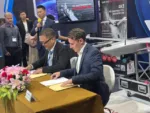The Indian Army is rapidly expanding its adoption of artificial intelligence (AI) technologies to enhance situational awareness, decision-making speed, and autonomous capabilities on the battlefield. This push aligns with India’s broader military modernization strategy and reflects a global trend toward digitized warfare driven by AI-enabled systems.
AI as a Force Multiplier in Modern Warfare
As peer adversaries increasingly leverage AI for military advantage—particularly China—the Indian Armed Forces are accelerating efforts to integrate AI into command-and-control (C2), surveillance systems, logistics automation, and unmanned platforms. Senior defense officials have described AI as a “force multiplier” capable of transforming conventional military operations into network-centric warfare environments.
According to Lt Gen MV Suchindra Kumar (Vice Chief of Army Staff), the Indian Army has already implemented over 85 AI projects across various operational domains. These include real-time video analytics for border surveillance, predictive maintenance algorithms for armored vehicles and helicopters, and natural language processing (NLP) tools for multilingual intelligence analysis.
Key operational areas where AI is being deployed include:
- ISR (Intelligence-Surveillance-Reconnaissance): Automated target recognition from EO/IR sensors and satellite imagery.
- C4ISR Systems: Decision-support tools that fuse data from multiple sources to generate actionable insights.
- Autonomous Systems: Robotic mules for logistics support in high-altitude terrain; swarm drones for reconnaissance missions.
- Cybersecurity: Threat detection using machine learning models trained on network traffic anomalies.
Institutional Push: iDEX-DefSpace and Defence AI Council
The Ministry of Defence (MoD) has institutionalized several frameworks to accelerate indigenous development of dual-use AI technologies. The Innovations for Defence Excellence (iDEX) program—under the Defence Innovation Organisation—has launched multiple challenges focused on autonomy in UAVs/UGVs, image recognition in ISR feeds, and predictive analytics in logistics chains.
Additionally, the Defence Artificial Intelligence Council (DAIC), chaired by the Raksha Mantri (Defence Minister), provides strategic oversight on cross-service adoption of AI. The DAIC works closely with the Defence Research and Development Organisation (DRDO), Bharat Electronics Limited (BEL), Bharat Dynamics Limited (BDL), and private sector firms such as Tonbo Imaging and Big Bang Boom Solutions.
The MoD’s “AI Stack” initiative aims to create a standardized framework—including datasets, APIs, simulators—for rapid prototyping of military-grade algorithms by startups and academia under DRDO mentorship.
Tactical Applications Already Fielded
A number of tactical-level applications have already been deployed or are undergoing user trials with frontline units:
- Bharat Drone Series: Developed by DRDO’s R&DE(E) lab in Pune—these lightweight quadcopters use onboard vision-based navigation and object recognition models trained on enemy vehicle signatures. They are optimized for high-altitude operations along the Line of Actual Control (LAC).
- Sentry Surveillance System: An automated perimeter monitoring system using thermal cameras fused with deep learning-based motion detection algorithms. Deployed at forward posts in Jammu & Kashmir.
- NLP-Based Translation Tools: Used by Military Intelligence units to process intercepted communications in Mandarin or regional dialects using transformer-based language models fine-tuned on defense-specific corpora.
- Ammunition Health Monitoring System: Predictive analytics platform that uses sensor data from ammunition storage depots to forecast shelf-life degradation or risk of instability due to temperature/humidity fluctuations.
A Growing Ecosystem of Defense-AI Collaboration
The Indian defense ecosystem is witnessing increasing collaboration between traditional public-sector undertakings (PSUs) like BEL/BDL/HAL and private startups focused on computer vision, edge computing hardware design, swarm robotics frameworks, etc. For instance:
- Tonbo Imaging: Supplies thermal imaging modules embedded with CNN-based object classifiers used in sniper scopes and UAV payloads.
- Sagar Defence Engineering: Developing autonomous surface vessels equipped with visual SLAM navigation powered by neural networks trained on maritime datasets.
- Tata Advanced Systems Ltd (TASL): Partnering with Israeli firm Elbit Systems to co-develop loitering munitions featuring onboard target discrimination algorithms based on convolutional neural networks (CNNs).
This ecosystem is further supported by academic institutions such as IIT Madras’ Robert Bosch Centre for Data Science & AI which collaborates with DRDO labs under technology transfer agreements focused on reinforcement learning algorithms for drone swarms operating in GPS-denied environments.
Challenges Ahead: Data Scarcity & Operational Validation
Despite these advances, significant challenges remain before India can field truly autonomous combat systems at scale. Chief among them is the lack of high-quality labeled datasets specific to military contexts—e.g., night-time EO/IR footage from Himalayan terrain or acoustic signatures from Chinese armored platforms—which limits model accuracy during real-world deployment scenarios.
The other major hurdle is operational validation under live-fire conditions or electronic warfare jamming environments. Many current prototypes have yet to be tested under contested electromagnetic spectrum conditions—a critical gap given China’s demonstrated EW capabilities along the LAC during recent standoffs. Additionally, ethical concerns around lethal autonomous weapons remain unresolved within India’s doctrinal framework despite growing interest in loitering munitions equipped with onboard kill-chain autonomy.
The Road Ahead: Toward Semi-Autonomous Combined Arms Operations
The Indian Army envisions a future where semi-autonomous systems operate alongside human soldiers across all domains—land-air-cyber—to enable faster OODA loops (“Observe–Orient–Decide–Act”). In this vision:
- Drones will provide persistent ISR coverage while relaying data via secure mesh networks powered by edge-AI chips optimized for low-latency inference;
- Cognitive radio systems will dynamically switch frequencies based on threat detection;
- Manned-unmanned teaming will be enabled via interoperable C4I architectures built around open standards like STANAG-4586;
- Tactical commanders will receive decision-support recommendations via augmented reality interfaces integrated into battlefield management systems like C3I-SR;
- Semi-autonomous UGVs will conduct route clearance missions using LiDAR+vision fusion models trained through synthetic simulation environments developed by CAIR-DRDO labs;
This transformation will require sustained investment not only in hardware but also algorithmic robustness under adversarial conditions—including spoofing-resistant GNSS modules; adversarial training datasets; explainable-AI frameworks; and doctrinal updates that define human-in-the-loop vs human-on-the-loop thresholds clearly across mission types.
Conclusion: From Experimentation to Operationalization
The Indian Army’s ongoing integration of artificial intelligence marks a pivotal shift toward future-ready combat formations capable of operating effectively across hybrid conflict scenarios—from counter-terrorism ops in Kashmir valleys to high-intensity peer conflicts along disputed borders. While early results are promising—with over five dozen projects already seeing field deployment—the transition from experimental prototypes to hardened battlefield systems remains an ongoing challenge requiring doctrinal clarity, rigorous testing protocols under EW stressors, indigenous dataset generation pipelines—and most critically—a clear ethical framework governing autonomy thresholds in lethal applications.









